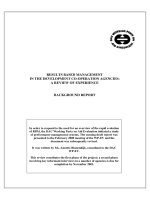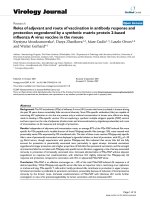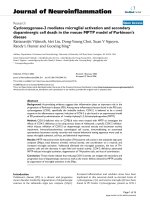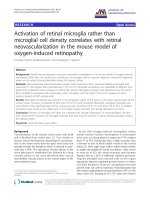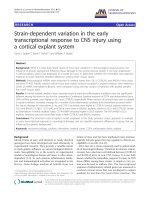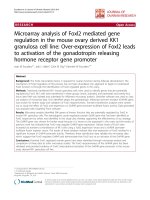Imaging experience dependent plasticity in the mouse barrel cortex
Bạn đang xem bản rút gọn của tài liệu. Xem và tải ngay bản đầy đủ của tài liệu tại đây (7.02 MB, 127 trang )
IMAGING EXPERIENCE-DEPENDENT
PLASTICITY IN THE MOUSE BARREL CORTEX
LO SHUN QIANG (A0023928A)
BACHELOR OF SCIENCE (HONS), NATIONAL
UNIVERSITY OF SINGAPORE
A THESIS SUBMITTED FOR THE DEGREE OF
DOCTOR OF PHILOSOPHY
DEPARTMENT OF PHYSIOLOGY
NATIONAL UNIVERSITY OF SINGAPORE
2014
1
Declaration
I hereby declare that this thesis is my original work and it has been
written by me in its entirety. I have duly acknowledged all the sources
of information which have been used in the thesis.
This thesis has also not been submitted for any degree in any
university previously.
_________________
Lo Shun Qiang
25
th
September 2014
2
Acknowledgements
This journey would not have been possible without the kindness
and help of many people. For that, I am deeply grateful and thankful for
all of you who have shaped my life and imparted valuable insights and
support. Firstly, I will like to thank George, my supervisor. You have
been a great mentor to me, and I will always be grateful for your
patience, guidance and care. I appreciate your help during all these
years, and will always continue to do my best to improve and to work
towards the truth as a scientist.
I will also like to thank Prof Soong for your kind help and
guidance as well. You took me in when I wanted to pursue
neuroscience, and I am grateful. Thank you to Prof Laszlo Orban for
taking me in as an intern during my undergraduate years and gifting
me with lots of encouragement and an enthusiasm to pursue research
and work at the lab.
Thank you to Dr Judy and Dawn from SICS, for introducing me
to the somatosensory cortex and for spending many afternoons
teaching me about immunohistochemistry and stereotaxic surgery. You
have always been kind and generous, and your support has been
invaluable during my candidature. Thank you too, to other members
from the Neuroepigenetics lab, Patrick, Vania, Fiza and Tendy, who
are great friends and have been a great help over the years.
I will also like to thank the many wonderful people I met in the
GA lab – especially Peggy and Harin for your support and friendship,
3
James, Greg and Jinsook for your advice and listening ears over the
years, Sachiko for being a great friend and neighbor, and Praneeth, for
having the patience to teach me the basics of Matlab programming and
signal processing. Thank you to the other members of the laboratory as
well, for being great friends and wonderful colleagues; Karen, Jennifer,
Masahiro, Martin, Sheeja, Su-In, Lei, Yanxia, Cherry, Isamu, Susu and
Zach.
I will also like to thank the Physiology department, NUS, the
facilities people at Biopolis, the friends I made at MBL, Woods Hole
and many other people who have provided assistance and helped me
along the way. Your help was much appreciated.
Thank you to my beloved Jasmine, for your love, support and
quiet strength. With you by my side, I could work hard and happily
without worry. Thank you to my dear parents and sister, and rest of my
family too, for your care, constant support and unconditional love. You
are all my role models.
Lastly, I will like to thank you, the reader, for taking the time to
go on this journey with me. I hope you will enjoy reading and find some
insights in my thesis.
4
Table of Contents
Declaration 1
Acknowledgements 2
List of publications 6
Abstract 8
List of figures 9
List of abbreviations 11
Chapter 1
Introduction 13
1.1 The relationship between whiskers and the somatosensory barrel
cortex 15
1.2 Multiple critical periods in the barrel cortex 18
1.3 Experience-dependent plasticity in inhibitory circuits 24
1.4 Voltage-sensitive dye imaging of circuit activity 29
1.5 Probing cortical circuits with optogenetic photostimulation 33
1.6 Summary and statement of purpose 36
Chapter 2
Materials and methods 40
2.1 Animals used 40
2.2 Sensory deprivation protocol 41
2.3 Slice preparation 41
2.4 Histological characterization 42
2.5 Voltage-sensitive dye imaging 44
2.6 High-speed Optogenetic mapping of inhibitory circuits 46
Chapter 3
Results 49
3.1 Imaging changes in circuit function caused by sensory
deprivation 49
5
3.2 Differential effects of deprivation on excitatory and inhibitory
circuits 59
3.3 Effects of deprivation on inhibitory feedback/feedforward circuit 65
3.4 Deprivation reduces inhibition by parvalbumin interneurons 75
Chapter 4
Discussion 92
4.1 A critical period for parvalbumin interneurons in the
somatosensory cortex 94
4.2 Differential effects of whisker deprivation on excitatory and
inhibitory circuits 99
4.3 The emergence of the layer 2/3 critical period 101
4.4 Future projections 108
Conclusion 112
References 113
6
List of publications
Neurosciences (related to the thesis)
Brent Asrican, George J. Augustine, Ken Berglund, Susu Chen, Nick
Chow, Karl Deisseroth, Guoping Feng, Bernd Gloss, Riichiro Hira,
Carolin Hoffmann, Haruo Kasai, Malvika Katarya, Jinsook Kim, John
Kudolo, Li Ming Lee, Shun Qiang Lo, James Mancuso, Masanori
Matsuzaki, Ryuichi Nakajima, Li Qiu, Gregory Tan, Yanxia Tang,
Jonathan T. Ting, Sachiko Tsuda, Lei Wen, Xuying Zhang and Shengli
Zhao (2013).
Next-generation transgenic mice for optogenetic analysis of
neural circuits
Front. Neural Circuits 7:160.
George J. Augustine, Susu Chen, Harin Gill, Malvika Katarya, Jinsook
Kim, John Kudolo, Li Ming Lee, Hyunjeong Lee, Shun Qiang Lo,
Ryuichi Nakajima, Min-Yoon Park, Gregory Tan, Yanxia Tang, Peggy
Teo, Sachiko Tsuda, Lei Wen, and Su-In Yoon (2013).
High-speed optogenetic circuit mapping.
Proc. SPIE, 8586, Optogenetics: Optical Methods for Cellular Control,
858603, edited by Samarendra K. Mohanty, Nitish V. Thakor.
George J. Augustine, Ken Berglund, Harin Gill, Carolin Hoffmann,
Malvika Katarya, Jinsook Kim, John Kudolo, Li M. Lee, Molly
Lee, Daniel Lo, Ryuichi Nakajima, Min Yoon Park, Gregory
Tan, Yanxia Tang. Peggy Teo, Sachiko Tsuda, Lei Wen, Su-In Yoon
(2012).
Optogenetic mapping of brain circuitry.
Proc. SPIE, 8548, Nanosystems in Engineering and Medicine, 85483Y
7
Neurosciences (unrelated to the thesis)
Chew KC, Ang ET, Tai YK, Tsang F, Lo SQ, Ong E, Ong WY, Shen
HM, Lim KL, Dawson VL, Dawson TM, Soong TW (2011).
Enhanced autophagy from chronic toxicity of iron and mutant
A53T α-synuclein: implications for neuronal cell death in
Parkinson disease.
J Biol Chem. 286:33380-33389.
Ang ET, Tai YK, Lo SQ, Seet R, Soong TW (2010).
Neurodegenerative diseases: exercising toward neurogenesis and
neuroregeneration.
Front. Aging Neurosci. 2:25
Genomics (unrelated to the thesis)
Kolics B, Ács Z, Chobanov DP, Orci KM, Qiang LS, Kovács
B, Kondorosy E, Decsi K, Taller J, Specziár A, Orbán L, Müller T.
(2012).
Re-visiting phylogenetic and taxonomic relationships in the genus
Saga (Insecta: Orthoptera).
PLoS One 7:e42229
Posters presented (related to the thesis):
Lo S.Q., Koh D., Sng J., Augustine G. (2013) Imaging experience-
dependent plasticity in the mouse barrel cortex.
The Society for Neuroscience 43
rd
Annual Meeting 2013, 9–13
November, San Diego, USA.
8
Abstract
During development, whisker loss affects the development and
function of somatosensory cortex circuits. However, the cellular and
molecular mechanisms underlying such experience-sensitive circuit
changes are poorly understood. I used voltage-sensitive dye imaging
and optogenetic circuit mapping in brain slices to characterize
experience-sensitive circuit changes occurring in layers 4 and 2/3 of
somatosensory cortex of whisker-deprived P30 mice. Deprivation
weakened synaptic inhibition because inhibitory postsynaptic potentials
evoked in layer 2/3 by electrical stimulation of layer 4 were reduced in
deprived slices compared to controls. Excitation also spread more into
neighboring barrels in deprived slices, indicating reduced columnar
specificity of excitatory circuits. To directly examine interneuron
contributions, I photostimulated parvalbumin-expressing (PV)
interneurons expressing the light-sensitive cation channel,
Channelrhodopsin-2. Sensory deprivation decreased the range and
amplitude of inhibitory postsynaptic current input onto layer 2/3
pyramidal neurons. This effect on PV interneurons is age-sensitive,
with the critical period time window closing around postnatal day 10.
My mapping of light-evoked IPSCs provides a quantitative and direct
measurement of the strength and spatial organization of this inhibitory
circuit and the response of this circuit to experience-dependent
plasticity. My characterisation of the PV interneuron critical period can
thus be used as a benchmark for identifying possible regulators of
critical period plasticity in this circuit.
9
List of figures
Figure 1.1: Critical periods in the somatosensory cortex
Figure 1.2: Simplified circuit diagram of parvalbumin circuits in the
barrel column
Figure 2.1: Barrels in slices
Figure 3.1: Voltage sensitive dye imaging of the barrel cortex slice
Figure 3.2: Postsynaptic layer 2/3 responses following layer 4
stimulation
Figure 3.3: Spatial range and time course of VSD responses along
column C
Figure 3.4: Characterization of population responses along entire
layers and in column C
Figure 3.5: Chronic sensory deprivation alters excitatory responses
following layer 4 stimulation
Figure 3.6: Chronic sensory deprivation alters the spread of
excitation
Figure 3.7: Chronic deprivation altered excitatory responses along
layer 4 but not layer 2/3
Figure 3.8: Chronic sensory deprivation did not significantly affect
postsynaptic EPSPs
Figure 3.9: Chronic sensory deprivation results in depressed IPSP
responses
Figure 3.10: Expression of ChR2 in Thy1 line-18 mice
Figure 3.11: All-optical mapping setup and photostimulation of layer 5
pyramidal neurons
Figure 3.12: Photostimulation of Layer 5 pyramidal neurons lead to
intercolumnal spread of postsynaptic activity
Figure 3.13: Chronic whisker deprivation did not significantly affect
layer 5 pyramidal neuron-driven excitatory responses in
all layers
Figure 3.14: Chronic whisker did not affect layer 5 feedback inhibition.
10
Figure 3.15: All-optical mapping with ChR2 photostimulation and VSD
imaging
Figure 3.16: Expression of ChR2 in parvalbumin interneurons in the
somatosensory cortex
Figure 3.17: Parvalbumin-expressing interneurons can be reliably
photostimulated
Figure 3.18: Recording IPSC input maps for layer 2/3 pyramidal
neurons
Figure 3.19: Chronic sensory deprivation beginning from P0
decreased IPSC amplitudes caused by parvalbumin-
expressing interneurons
Figure 3.20: IPSC input strength was significantly decreased in
deprived slices along layers 2/3 and 4
Figure 3.21: Chronic sensory deprivation consistently decreased IPSC
amplitudes but did not affect input areas across layers
Figure 3.22: The sensitivity of parvalbumin interneuron-mediated
IPSCs to whisker deprivation decreases with
developmental age
Figure 3.23: A critical period for experience-dependent plasticity for
the parvalbumin interneurons to pyramidal neuron circuit
in the somatosensory cortex
Figure 4.1: Critical periods in the somatosensory cortex
11
List of abbreviations
ACSF artificial cerebral spinal fluid
AMPA 2-amino-3-(5-methyl-3-oxo-1,2-oxazol-4-yl) propanoic acid
BDNF brain-derived neurotrophic factor
ChR2 Channelrhodopsin-2
CNQX 6-cyano-7-nitroquinoxaline-2,3-dione
EGTA ethylenediamine tetraacetic acid
EPSC excitatory postsynaptic current
EPSP excitatory postsynaptic potential
EYFP enhanced yellow fluorescent protein
FRET Förster resonance energy transfer
GABA gamma-aminobutyric acid
GFP green fluorescence protein
I-O input-output
IPSC inhibitory postsynaptic current
IPSP inhibitory postsynaptic potential
LTD long-term depression
LTP long-term potentiation
NpHR Natronomas pharaonis halorhodopsin
P0 postnatal day 0
PTX picrotoxin
PV parvalbumin
SOM somatostatin
12
VPM ventral posterior medial
VSD voltage-sensitive dye
WT wild type
13
Chapter 1
Introduction
The “critical period” is a time window of heightened neuronal
plasticity, when cortical circuits are particularly susceptible to regulation
by sensory input provided by environmental stimuli (Jeanmonod et al.,
1981). First identified in the visual cortex by Huber and Wiesel (1963b),
critical periods tend to be rigidly defined in time and irreversible
(Fagiolini et al., 2009; Sweatt, 2009). A prominent example of this
phenomenon is found in the somatosensory barrel cortex of rodents,
where loss of whisker input leads to a loss of structural organisation in
layer 4 neurons and synapses (Van der Loos and Woolsey, 1973).
These layer 4 neurons and synapses normally cluster into discrete
groups aligned with cortical columns and form an array known as the
“barrel field”, but this organisation is lost when sensory input is
deprived early in development (Van der Loos and Woolsey, 1973). This
experience-dependent change in spatial organization is associated with
synaptic changes (Fox, 1992). Unlike in the visual cortex, which has a
single critical period as defined by the ocular dominance plasticity
phenomenon (Wiesel and Hubel, 1963a), multiple critical periods have
been observed within different layers in the barrel cortex (Foeller and
Feldman, 2004). Even for excitatory circuits within layer 2/3, discrete
and dissociated critical periods can be observed for synapses within
layer 2/3 and between layer 4 to 2/3 (Wen and Barth, 2011). These
critical period processes span different time points during early brain
development and emerge with a range of structural or physiological
14
changes that can be traced to the formation and maturation of
individual circuits (Foeller and Feldman, 2004; Petersen, 2007; Fox,
2008).
Given that the somatosensory cortex consists of multiple
functional networks made up of many cell types and is further stratified
into both columns and layers (Fox, 2008), the critical period apparently
reflects differential development of individual cortical circuits. Recent
studies have highlighted inhibitory circuit regulation as an important
mechanism for regulation of the critical period in both the visual and
somatosensory cortices (Hensch and Fagiolini, 2005; Jiao et al., 2006;
Southwell et al., 2010; Keck et al., 2011; Katzel and Miesenbock,
2014). However, relatively little is known about inhibitory circuit
plasticity in the somatosensory cortex, so the nature of the experience-
dependent plasticity that might be occurring in these circuits is unclear.
In my thesis, I have examined the effects of deprivation of sensory
input from postnatal (P) days P0 – P30 on circuits in the
somatosensory cortex, with particular emphasis on inhibitory circuits. I
found that chronic sensory deprivation led to decreased postsynaptic
inhibitory potentials (IPSPs) in layer 2/3. The decrease in inhibition was
mediated by parvalbumin (PV) interneurons, which have a critical
period of sensitivity to sensory experience for the first two postnatal
weeks of development.
In the next few sections, I will summarize what is known about
experience-dependent plasticity and critical periods in the
somatosensory cortex, and in inhibitory circuits in particular. This
15
background will serve as the basis for me to define the questions I
have addressed and the approaches necessary to answer these
questions.
1.1 The relationship between whiskers and the somatosensory barrel
cortex
Many species have whiskers (also known as vibrissae). In some
animals, such as mice and rats, the whiskers constitute an especially
sensitive and important sense organ for perceiving their environment.
This is reflected in the high degree of cortical area dedicated to
processing somatosensory signals from the whiskers (Lee and
Erzurumlu, 2005). During exploration of the environment, active
whisking occurs by protraction and retraction of the whiskers as the
rodent searches for and makes contact with objects (Welker, 1964).
Whiskers are already present at birth; the development of this active
protraction and retraction of whiskers for active sensing and exploration
develops as early as P7 in rodents. This is much earlier than for vision,
which starts at P17 (Welker, 1964). The whiskers carry important
somatosensory information that allows the rodent to make sense of
both the location and physical properties of surrounding objects
(Schiffman et al., 1970; Hutson and Masterton, 1986; Krupa et al.,
2001; Diamond et al., 2008), discriminate between textures (Zuo et al.,
2011), gap crossing (Jenkinson and Glickstein, 2000) and to facilitate
navigation in the dark (Hughes, 2007). Sensory information is
16
processed in the somatosensory cortex, as demonstrated by the fact
that lesions in the cortex impair the ability of mice to judge distances
with their whiskers and successfully cross large gaps (Troncoso et al.,
2004). Furthermore, whisker trimming during P0–P3 impairs the ability
of rats to sense and navigate these gaps, even with regrown whiskers,
indicating the existence of a close relationship between whisker activity
and cortical development (Lee et al., 2009).
From the whiskers, there is a dedicated pathway for information
flow to the somatosensory cortex. The whisker ends at the follicle,
where endings of the trigeminal nerve wrap around the base of the
whisker (Diamond et al., 2008). This arrangement allows movement of
the whisker to activate firing of individual sensory neurons in the
trigeminal nerve (Petersen, 2007; Diamond et al., 2008). Sensory
neurons are dedicated to the movement of particular whiskers and are
organized as clusters of neurons forming similarly dedicated
“barrelettes” in the principal trigeminal nucleus (Veinante and
Deschenes, 1999). These barrelettes form the first layer of somatotopic
representation of the whiskers (Veinante and Deschenes, 1999). The
trigeminal neurons then project into the ventral posterior medial (VPM)
nucleus of the thalamus, forming another layer of somatotopic
representation called the “barreloids” (Petersen, 2007). From the VPM,
there are long-range axons that innervate layer 4 of the six-layered
somatosensory cortex (Petersen, 2007). Because these axons form
discrete clusters of synapses with layer 4 neurons, another layer of
somatotopic representation is made at the cortex. At the level of the
17
VPM and the cortex, each group responds most actively to their
dedicated or principal whisker and much less to surrounding whiskers
(Brecht and Sakmann, 2002a, b).
At layer 4, where the main input of sensory information arrives
into the cortex, structures known as “barrels” are seen (Woolsey and
Van der Loos, 1970). This structure is defined by its resemblance to
Bruugel’s painting of barrels; this emphasizes the 3-dimensional nature
of the structure and the density of cells at the edge of the “hollow”
barrel (Woolsey and Van der Loos, 1970). Layer 4 cells at the edge of
the barrels project their dendrites towards the center, where they form
synapses with thalamocortical axons (Simons and Woolsey, 1984).
During normal development, the barrel thus gains its unusual
appearance because the center of the barrels mainly consists of a
collection of processes and synapses, resulting in uneven cell density
along layer 4 (Fox, 2008). In the mouse, these barrels are organized
close to each other to form a barrel field (Petersen, 2007). Remarkably,
this trisynaptic connection between the whiskers, barrelettes, barreloids
and barrels creates a major dedicated pathway where cortical neurons
are grouped to form an almost identical organization to the whisker pad.
The presence of these discrete “barrel” structures in layer 4 of
the somatosensory cortex serves as a convenient anatomical landmark
demarcating layers and columns (Woolsey and Van der Loos, 1970). In
these vertical columns, neurons form connections that spread
throughout all cortical layers (Mountcastle, 1957). Each column
constitutes a single repeatable unit with similar circuits, and the
18
neurons in each column processes the same sensory modality
(Mountcastle, 1997). The existence of specific corresponding
barrel-whisker pairings allow one-to-one mapping of experience-
dependent whisker activity with specific columns in the brain (Petersen,
2007). Thus, this field of barrels in the cortex forms a somatotopic
representation of the whisker pad. This convenient somatotopic map
allows one to set up experiments where whisker experience can be
manipulated and, thereby, conveniently study how sensory input
shapes circuit development during specific time periods (Fox, 2008;
Petersen, 2007).
1.2 Multiple critical periods in the barrel cortex
Barrels develop by postnatal day 5 (Woolsey and Wann, 1976).
This indicates that the neurons and synapses within layer 4 that form
the characteristic barrel field develop their structural organization by P5.
Remarkably, injury to parts of the whisker pad at birth leads to the loss
of corresponding barrels in the somatosensory cortex (Van der Loos
and Woolsey, 1973). This classical finding provided the first evidence
that sensory deprivation during development could alter the structure of
circuitry in the somatosensory cortex. Because layer 4 barrels are
dense clusters of synapses between long-range thalamocortical axons
and layer 4 neurons, it is evident that sensory input is critical for the
proper development and organization of these synapses.
19
This structural relationship between the peripheral whisker pad
and the patterning of central cortical cells has a limited time window of
sensitivity. Whisker pad damage at P1 results in aberrations in the
barrel field, but this effect is minimal if the procedure is done at P5
(Weller and Johnson, 1975) and is absent in the case of P7 deprivation
(Woolsey and Wann, 1976). The change in barrel area with
cauterization of the whisker pad is caused by reorganization of
thalamocortical innervation of layer 4 (Woolsey and Wann, 1976).
During development, this innervation of long-range axons is greatest at
P5 and any reduction in the deprived barrel is accompanied by
expansion of spared neighboring barrels (Woolsey and Wann, 1976).
In contrast, there is no observable effects of cauterization on the
structure of the ipsilateral somatosensory cortex used as a control
(Woolsey and Wann, 1976). Hence, in mice there is a critical period for
the layer 4 barrel structure – between P0 and P7 – during which
whisker loss can affect barrel field formation.
Whisker pad damage is also accompanied by corresponding
shrinkage of activatable layer 4 receptive field sizes at the cortex, while
maintaining the normal topographic organization of the functional map
(Simons et al., 1984). Representation of spared whiskers expands into
the deprived regions, such that stimulation of the spared whisker can
then activate neurons in the column associated with the lost whisker
(Simons et al., 1984). These changes in the activity of the barrel cortex
are mainly due to sensory experience during the early layer 4 critical
period, and can be evoked by trimming whiskers without damaging the
20
follicle (Simons and Land, 1987). Hence, the development of cortical
circuits is highly dependent on sensory experience.
Different cortical layers respond differently to sensory
experience (Diamond et al., 1994). Besides the critical period of the
layer 4 barrel field, the mouse somatosensory barrel cortex possesses
at least two more known periods of dynamic, experience-dependent
plasticity (Figure 1.1; Fox, 2008);
The layer 2/3 receptive field critical period which occurs during
P9–P14 (Stern et al., 2001). However, it is not clear whether this
receptive field critical period exists before P9. Spine motility
changes in layer 2/3 are seen during this period as well (Lendvai
et al., 2000). Unlike the irreversible structural critical period of
layer 4 barrels, layer 2/3 receptive field critical period has some,
albeit limited, plasticity in adulthood.
Layer 5 shows experience-dependent plasticity, but the period of
plasticity is not clear. It is thought to extend into adulthood.
Although layer 2/3 circuits exhibit plasticity into adulthood
(Diamond et al., 1994; Glazewski and Fox, 1996), a second critical
period regarding the development of columnar receptive fields can be
observed from P11–P14 (Lendvai et al., 2000; Stern et al., 2001).
Layer 2/3 receptive field maps mainly consist of excitatory circuits
between layer 4 and layer 2/3, as well as intralaminar circuits between
layer 2/3 neurons (Foeller and Feldman, 2004). Loss of whiskers for
1–3 days reduces the motility of layer 2/3 dendritic spines without
affecting their structural stability, but only if deprivation was done
between P11–P13 and not before or after (Lendvai et al., 2000). This
coincides with a period of rapid spine formation (Micheva and Beaulieu,
1996) and the onset of active exploratory whisking behavior (Welker,
1964) at P10–P15, suggesting that sensory input is important for the
development of receptive field maps. Indeed, sensory deprivation
before P14 disrupts receptive field structure within layer 2/3, while
these maps are resistant to manipulations of whisker experience after
P14 (Stern et al., 2001). This is facilitated by the reorganization of the
excitatory circuits between layer 4 and layer 2/3; when all whiskers are
trimmed from P9–P14, receptive fields in layer 2/3 broaden, while
those in layer 4 do not (Shepherd et al., 2003). These changes affect
the tuning of topographic maps in layer 2/3 (Lendvai et al., 2000). Past
the critical period, timing-dependent long-term potentiation (LTP) and
long-term depression (LTD) have been observed for the circuit
between layer 4 cells and layer 2/3 pyramidal neurons between P15–
P30 (Feldman, 2000). These synaptic plasticity mechanisms are
thought to contribute to receptive field map plasticity as well (Feldman,
2000).
Layer 5 field responses are also susceptible to whisker
deprivation (Diamond et al., 1994), though it is not yet clear whether
there is a defined critical period for layer 5 plasticity. Sensory
deprivation increases the excitability of layer 5 pyramidal neuron
dendrites, partly by decreasing the expression dendritic HCN channels
23
(Breton and Stuart, 2009). In addition, there is also evidence that
cortical oscillations and recurrent firing caused by whisking behaviour
can induce plasticity, in the form of either increases or decreases in
layer 5 pyramidal neuron excitability (Mahon and Charpier, 2012).
In summary, many different types of plasticity have been
observed in the barrel cortex in response to whisker manipulation,
including LTP and LTD, structural changes in processes and dendritic
spines (Lendvai et al., 2000), and even changes in layer 4 inhibitory
synapse number (Foeller and Feldman, 2004; Feldman and Brecht,
2005). Some of these changes are long-lasting and have a critical
period of sensitivity to sensory experience.
The existence of multiple critical periods and multiple types of
plasticity in the barrel cortex is likely to reflect varying time periods for
developmental plasticity at different subgroups of synapses. However,
the mechanisms ultimately regulating experience-dependent plasticity
are not yet clear. In addition, the presence of multiple plasticity events
involving different layers and circuits during development of the barrel
cortex brings up the question of whether still other circuits are also
sensitive to experience. Defining which neurons underlie experience-
dependent plasticity and testing whether they have critical periods of
sensitivity separate from those described above will provide useful
insights into how layer-specific critical periods may arise from the
development of individual circuits and the basis for testing how critical
period plasticity can be manipulated in the future. The ability to
manipulate and reinitiate critical period plasticity in adulthood will allow
24
treatment of disabilities arising from a lack of sensory experience
during development.
1.3 Experience-dependent plasticity in inhibitory circuits
Although studies of these critical periods in layers 2/3 and 4
have mainly focused on excitatory synapses, recent studies suggest an
important role for inhibitory circuits as well (Foeller and Feldman, 2004;
Southwell et al., 2010). Pharmacologically enhancing GABAergic
transmission seems to bring forward critical period plasticity in circuits
of the visual cortex (Fagiolini and Hensch, 2000; Iwai et al., 2003;
Fagiolini et al., 2004), while preventing GABAergic synaptic
transmission by deleting the Gad65 gene delays the onset of cortical
plasticity (Hensch et al., 1998). The efficacy of GABA transmission
presumably affects critical period plasticity by altering the balance of
cortical excitation and inhibition necessary for plasticity to occur
(Hensch, 2005b). Some support that a balance between cortical
excitation and inhibition is indeed required for proper critical period
development can be found in the observation that overexpression of
brain-derived neurotrophic factor (BDNF) initiates earlier cortical
plasticity associated with the critical period and does so by inducing
maturation of inhibitory interneurons (Hanover et al., 1999; Huang et
al., 1999). Hence, it is evident that inhibitory circuits can play an
important role in critical period plasticity, although how they actually
contribute is unclear.

